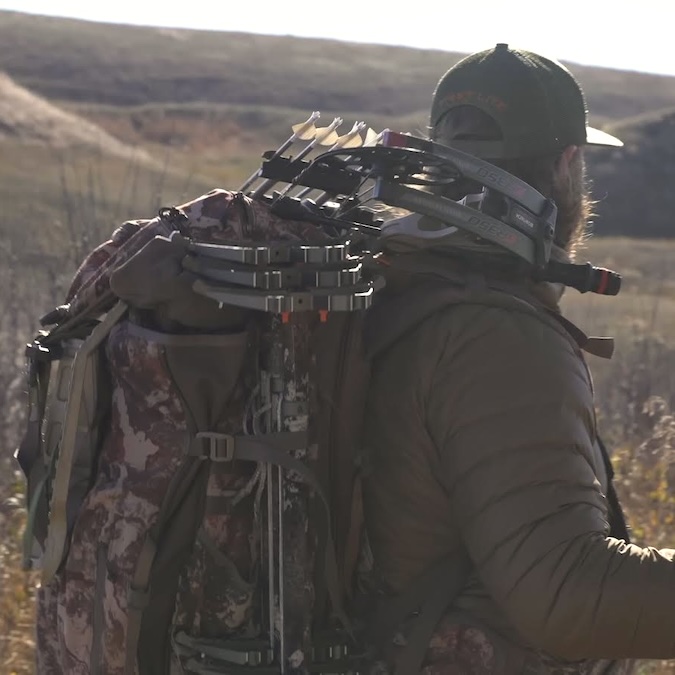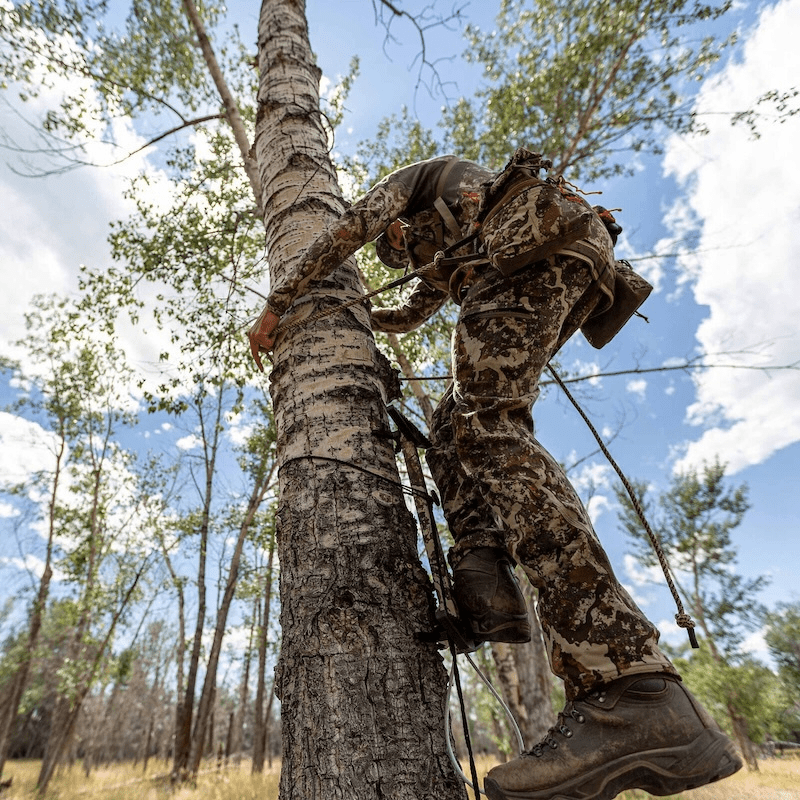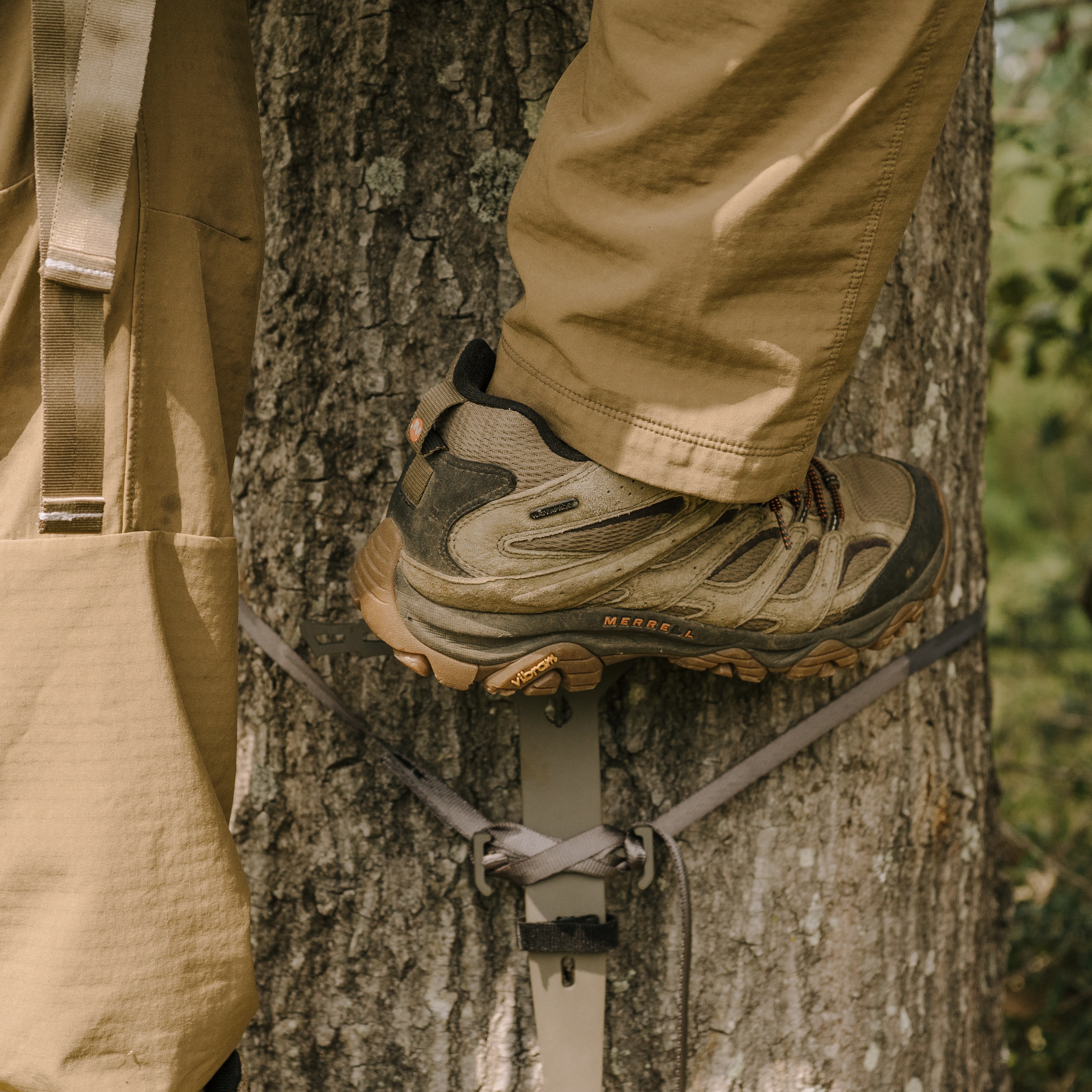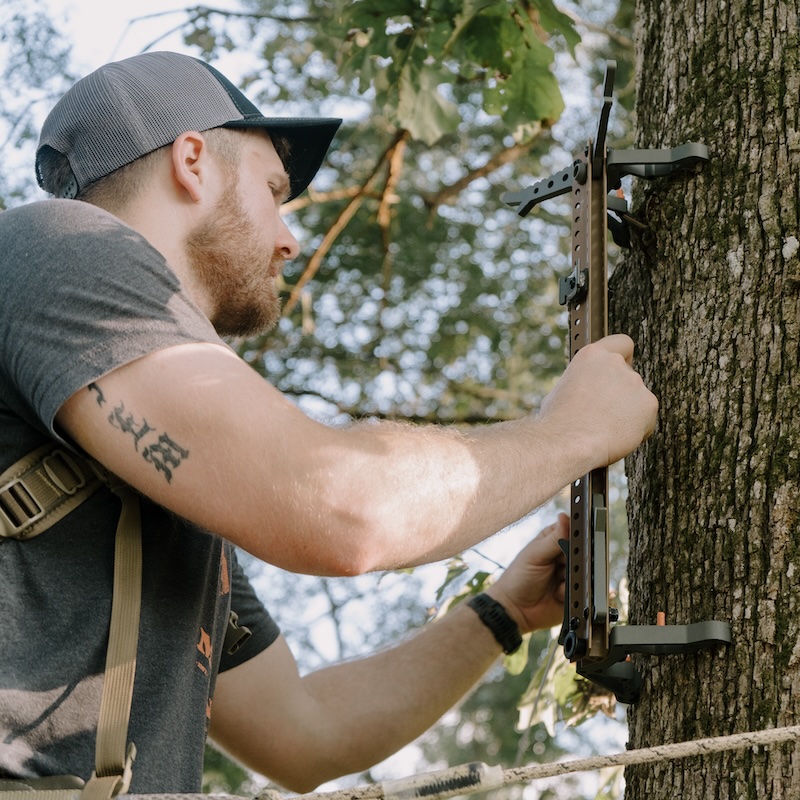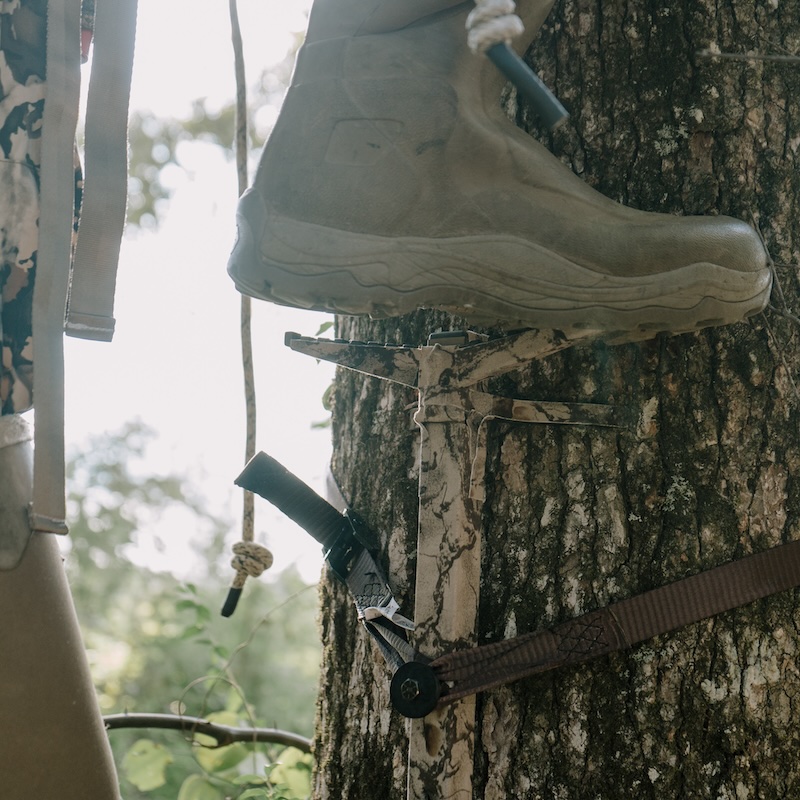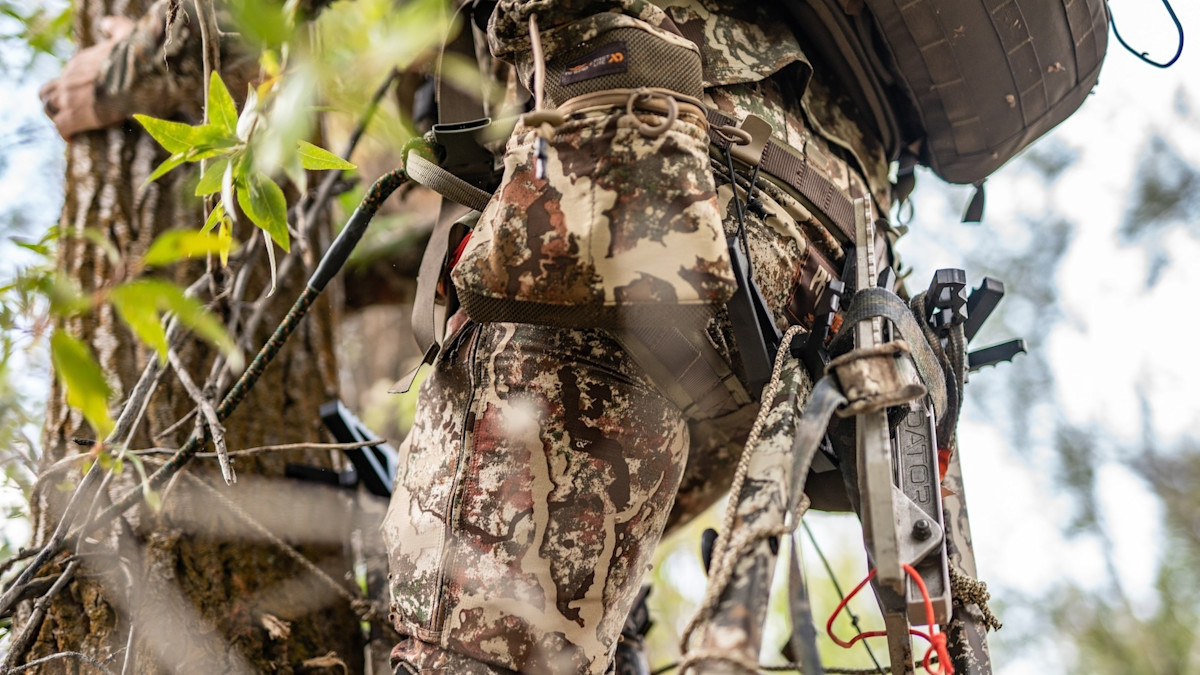
Lightweight hang-on stands or tree saddles might be the focal point of mobile hunting setups, but climbing sticks are the cornerstone. You might as well hunt from an old climber if your sticks add double-digit weight to your setup. Luckily, companies are in an arms race to produce ultralight and ultra-quiet climbing sticks, and the market is better for it.
This fortunate dilemma leaves hunters with ample choices when it comes to lightweight climbing sticks. Combined, the MeatEater crew logs hundreds of sits in the saddle or stand each season, and we’ve tested or hunted with some of the best climbing sticks available. Whether you’re thinking of joining the cult following of saddle hunters or buying a lightweight hang-on tree stand, you’ll need a set of climbing sticks, and these are the ones we prefer.
Jump to: The Climbing Sticks We Use
What We Look For In A Good Climbing Stick
Just about any climbing stick will serve the purpose of helping you ascend a tree. However, there are a few features that separate the clunkers from legit options.
- Stealth
- Packability
- Light Weight
- Ease of Use
It doesn’t matter how mobile you can get, if your climbing sticks are loud and difficult to set up, you’re not exactly being stealthy. While most options weigh between one to two pounds, you’ll want to consider whether the price difference in a pound makes sense for your budget and hunting strategy.
Jump to: What Makes A Good Climbing Stick
The Climbing Sticks We Use
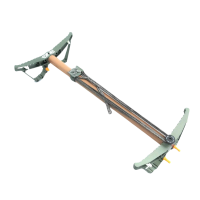 Tethrd One Stick K.C., Tyler, & Mark's Pick
|
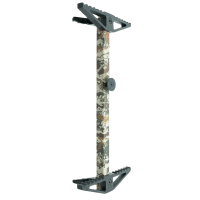 Timber Ninja C1 Tony’s's Pick
|
 Lone Wolf Custom Gear Micro Doubles Adam's Pick
|
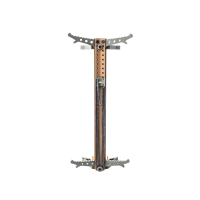 Tethrd Skeletors
|
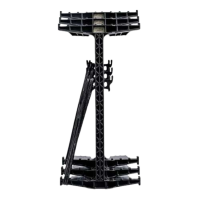 Latitude Outdoors Carbon SS
|
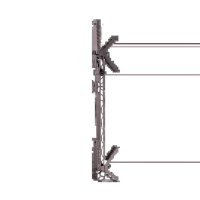 Lone Wolf Custom Gear Compact Doubles
|
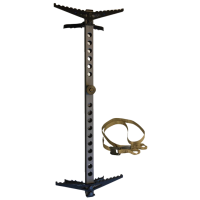 Beast Gear Climbing Stick
|
|
|---|---|---|---|---|---|---|---|
| Highlight | Best Overall | Quietest | Most Compact | Best Budget | Best Value | Most Versatile | Best Tree Bite |
| Weight (Per Stick) | 1 lbs. | 1.2 lbs. | 1 lb. | 2 lbs. | 1.18 lbs. | 1.7 lbs. | 1.7 lbs. |
| Total Length | 20.5 in. | 20 in. | 17 in. | 24 in. | 18 in. | 14 in. | 20 in. |
| Weight Limit | 300 lbs. | 300 lbs. | 300 lbs. | 300 lbs. | 275 lbs. | 300 lbs. | 300 lbs. |
| Material | Titanium/aluminum | Carbon fiber/polymer | Aluminum | Aluminum | Carbon Fiber | Metal Alloy | Aluminum |
| Price | $350 (3-pack)* | $165 ea.* | $150 ea.* | $225 (Only sold in 4-Pack)* | $84 ea.* | $149 ea.* | $112 ea.* |
| Field Notes | Field Notes | Field Notes | Field Notes | Field Notes | Field Notes | Field Notes |
What Makes A Good Climbing Stick
Whether you’re just joining the mobile hunting trend or you’re looking for the best bang for your buck, make sure you consider these attributes before pulling the trigger.
Stealth
Packability
Light Weight
Ease of Use
Expensive, lightweight climbing sticks won’t do you any good if they ring like a gong every time you bump them. Most sticks require some type of aftermarket silencing. If you’re already spending several hundred dollars on some of the best climbing sticks, go ahead and spend another twenty to silence them.
While weight matters, you should also consider a stick’s stack height and how well it packs down. If you’re shopping for one-pound climbing sticks, this shouldn’t be an issue. However, heavier, full-sized sticks might take up a lot of real estate on your pack or snag on brush as you’re walking through the woods.
It’s not like saddle hunters have to count ounces like backcountry elk hunters, but the lighter the stick, the better. Whether you’re walking to your spot or hanging a set, lightweight climbing sticks make it easier.
The best climbing sticks typically feature a quick rope attachment system that you could probably set up or tear down in the dark. Others have straps that require a bit more attention. Sticks with quick, convenient containment systems for their ropes/straps will also save you time and hassle in the woods.
Field Notes from the MeatEater Crew
K.C., Tyler Jones, and Mark Kenyon's Pick
Best Overall
There are tons of climbing sticks available, but for K.C. Smith, Tyler Jones, and Mark Kenyon, but the Tethrd One Stick stands out.
"On the matter of climbing sticks, I may just have them all," Smith said. "but the Tethrd One stick is the clear choice for me. It’s insanely light, has incredible tree bite, and the easiest attachment system I’ve ever used."
Tyler Jones also cited the One Stick’s tree bite as one of its most impressive features. He also highlighted the angled step, which he noted offers enough space for someone “with a size 14 boot” to comfortably climb.
The one drawback everyone mentioned was the hollow noise the actual stick makes when bumped. To be fair, most sticks aren’t totally silent out of the box and require some kind of aftermarket silencing.
Specifications
- Weight (Per Stick): 1 lbs.
- Total Length: 20.5 in.
- Weight Limit: 300 lbs.
- Material: Titanium/aluminum
- Pros: Super light, Tethrd’s rope containment system, Great tree bite, Quick/easy setup
- Cons: Pricey, Requires aftermarket silencing
- Price: $350 (3-pack)
Tony's Pick
Quietest
MeatEater’s Tony Peterson was mobile hunting long before it was cool and trendy. He’s also seen the revolving door of hunting gear fads throughout the years, so he can spot the pretenders. For the past few seasons, he’s been running the Timber Ninja C1 Carbon Fiber Sticks, which have been a “game-changer” for him.
"I can carry four or five of the 20-inch sticks and still be at or under six pounds, which is incredible," he said. "If you do a lot of mobile hunting and want to stay stealthy doing it, I don't know if there’s a better option."
While you can Stealth Strip to your heart’s content, Peterson pointed out that the C1 sticks are quiet, even out of the box. The C1’s carbon fiber and polymer materials help keep the noise down, so you don’t have to worry about a loud clang or hollow knock when you attach them to the tree. The C1 sticks also have a relatively low stack height, which makes them easier to attach to a pack if you’re limited on storage.
Specifications
- Weight (Per Stick): 1.2 lbs.
- Total Length: 20 in.
- Weight Limit: 300 lbs.
- Material: Carbon fiber/polymer
- Pros: Small footprint, Ultralight, Quiet out of the box, Small stack height, Retractable aiders
- Cons: Pricey, Minimal toe clearance
- Price: $165 ea.
Adam's Pick
Most Compact
For the ultra-minimalist, I can’t think of a better climbing stick. The LWCG Micro Doubles weigh just under one pound and offer a four-inch stack height, which makes them extremely packable. Paired with an aider, three of the Micro Doubles offer plenty of options when it comes to climbing height, and the attachment system requires a simple figure-eight.
The most notable feature (other than size) of the Micro Doubles is the stick’s ability to flex. This took some getting used to, but this feature allows the stick to contour to weird tree shapes and produce an even better bite. The aluminum/metal material is highly durable and boasts a 300-pound weight limit, and I had zero durability concerns while climbing with these sticks.
Out of the box, these sticks require silencing, as the metal-to-metal contact isn’t very forgiving. But other than the Timber Ninja C1s, I’m not sure what climbing sticks don’t require Stealth Strip or hockey tape. The only demerit I noted deals with foot clearance. The small stack height makes this inevitable, so it’s worth considering if you only wear rubber boots or have large feet.
The Micro Doubles are extremely packable, quick to set up/tear down, and super lightweight, but all those premium features demand a premium price. However, these features also make them one of the best climbing sticks that will give you years of reliable service.
Specifications
- Weight (Per Stick): 1 lbs.
- Total Length: 17 in.
- Weight Limit: 300 lbs.
- Material: Aluminum
- Pros: Pack/space friendly, Aggressive tree bite, Made in U.S., Minimal stack height
- Cons: Requires aftermarket silencing, Minimal foot clearance
- Price: $150 ea.
Best Budget
I’ve used the Tethrd Skeletors on and off for the past several seasons. Even though they’re considered “heavy” in the company of one-pound sticks, their packability, rope containment system, and generous foot space keep them in my rotation. They’re super quick to setup and tear down even in the dark.
Most folks will scoff at the Skeletors’ weight (two pounds per stick), but they’re hardly heavy. Not to mention, the StickLoc pin system allows you to pack them tightly together, which makes them compact during transport. Sure, if you’re hunting Appalachia, a lighter stick might make your long trek a bit easier, but the Skeletors shouldn’t slow you down.
While they have a good tree-bite, it doesn’t compare to something like the Beast Gear climbing sticks. I also keep an allen key in my pack, as the hardware tends to loosen over time. However, these are minor issues. For the money, the Tethrd Skeletors are one of the best climbing sticks available.
Specifications
- Weight (Per Stick): 2 lbs
- Total Length: 24 in.
- Weight Limit: 300 lbs.
- Material: Aluminum
- Pros: Affordable, Quick setup, Great rope containment system, Good foot clearance
- Cons: Hardware requires occasional retightening, "Heavy" by lightweight standards
- Price: $225 (Only sold in 4-Pack)
Best Value
Lightweight (one-pound) climbing sticks typically command a steep price. The durable, lightweight materials usually cost more than the aluminum budget steps you’ll find. However, Latitude Outdoors Carbon SS climbing sticks offer a great value for a stick that weighs just over one pound. Part of this has to do with how it’s made. The Carbon SS consists of a single piece of material.
As you can infer from the name, the Carbon SS are super light. I recently packed them on a scouting trip to hang trail cameras, and they were unnoticeable. While these sticks won’t make the sound of two metal sticks, but I would still recommend Stealth Stripping them.
Like the Skeletors and One Sticks, the Carbon SS have an Amsteel rope that allows for quick setup/breakdowns. There’s probably more rope on here than you’ll need, but it’s better to have than have not. I also appreciate the included rubber belt clip that fastens the stick together. It’s silent, convenient, and quicker to fasten than a typical strap.
While climbing with the Carbon SS Sticks, I noticed they do a great job staying in place. I think the single-piece construction helps with this, even though the teeth appear less than ideal for biting the tree. However, I never had an issue with the sticks moving out of place while ascending/descending the tree.
I’ve hunted or climbed with several different brands of sticks, and the Carbon SS sticks present the best value by far. A set of four will run you $335. That’s roughly $84 per stick, which is almost half the price of other one-pound sticks.
Specifications
- Weight (Per Stick): 1.18 lbs.
- Total Length: 18 in.
- Weight Limit: 275 lbs.
- Material: Carbon Fiber
- Pros: Excellent value, Entire stick is one piece, Speedy setup, Easy stacking for transport
- Cons: Durability concerns, Tree bite could be better, Large stack height
- Price: $84 ea.
Most Versatile
Sometimes the killing tree isn’t the one with a straight, limb-free trunk. Typical double steps can be challenging to mount, especially if you’re hunting public land where tree trimming isn’t allowed. Lone Wolf’s Compact Doubles solve this dilemma. Thanks to the pivoting V-brackets and butterfly steps, you can climb trees that have tons of limbs without making alterations to the tree.
Not only do the pivoting V-brackets have a great tree bite, but their angle provides plenty of boot clearance while climbing. You can also adjust the butterfly steps silently, and they require some force, which means you won’t have to worry about accidentally bumping them during your ascent/descent.
But these features that make climbing so streamlined also make packing the sticks, which is half the battle, a breeze. The rubber grommets also allow you to connect the sticks for transport, so you don’t have to worry about another strap to keep up with. The MOLLE ascender hook, a subtle but gold feature, quickly and conveniently clips to your saddle, belt, etc., while climbing. It’s just another aspect that highlights what this stick does best—quick, versatile setups.
Like the Micro Doubles, these sticks command a steep price and require aftermarket silencing. If you’re looking for a lightweight option that offers excellent tree bite and versatile mounting capabilities, the Compact Doubles warrant serious consideration.
Specifications
- Weight (Per Stick): 1.7 lbs.
- Total Length: 14 in.
- Weight Limit: 300 lbs.
- Material: Metal Alloy
- Pros: Butterfly steps great for trees with low/lots of branches, Lightweight, J-hook attachment for LWCG stand, Made in U.S., Pivoting V-Bracket allows for various packing options
- Cons: Pricey, Silencing is a must
- Price: $149 ea.
Best Tree Bite
Of all the climbing sticks I’ve hunted with, the Beast Gear Climbing Sticks have the best tree bite. Once you (properly) attach them to the tree, there’s no play or slippage, which is reassuring when you’re climbing down in the cold and dark. While not included, you can purchase a stick that allows you to neatly stack them together, but a strap works just as well, too.
The Beast Gear Climbing Sticks boast a large stack height that eats up room on a pack, but it is manageable. You’ll also have to buy the Stealth Stripping kit for these sticks. Some climbing sticks can go without it, but these are definitely not one of them.
While these sticks aren’t the most expensive, they’ll run you $109 a piece, which is still thirty dollars less (per stick) than the LWCG or Timber Ninja C1 options. Even when you add in the necessary stealth stripping kits, you still get four of the best climbing sticks for around $500.
Specifications
- Weight (Per Stick): 1.7 lbs.
- Total Length: 20 in.
- Weight Limit: 300 lbs.
- Material: Aluminum
- Pros: Excellent tree bite, Generous step space, Super durable, Aggressive steps for traction, Reasonable price
- Cons: Requires aftermarket silencing, Large stack height
- Price: $112 ea.

